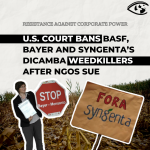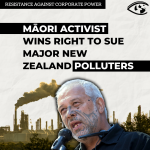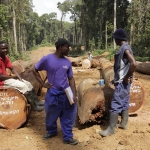Albemarle Corporation
Bromide Baron Rap Sheet #1
Address: 330 South Fourth Street, Richmond, VA 23210
CEO: Floyd D. Gottwald Jr.
Tel: (504) 388-7693
Website: Albemarle home page
 Major Businesses: Bromine chemicals including methyl bromide, flame
Major Businesses: Bromine chemicals including methyl bromide, flame
retardants; speciality chemicals: ibuprofen, MMT gasoline additive,
detergents and surfactants.
Operations: Plants and facilities in Arkansas, Texas, South
Carolina, Belgium and France.
Revenues: $1.2 billion in 1995
Profits: $78 million in 1995
Member: Methyl
Bromide Working Group, Methyl Bromide Global Coalition, the European Methyl Bromide Association.
Today the Albemarle Corporation is one of the top three producers of methyl bromide in the world. Founded in 1887 to produce blotting papers for fountain pens, Albemarle stayed a paper products company for many years. In 1962 however, the Gottwald family -- controllers of Albemarle, borrowed $200 million to buy the Ethyl Corporation. Through the merger, they took on Ethyl's name. Building on Ethyl's infamous gasoline additive -- tetraethyl lead (TEL) -- the Gottwalds built Ethyl into a major chemical corporation
that, among other activities, played a leadership role in the bromine industry.
In 1994, as methyl bromide came under increasing attack, the Gottwalds divested Ethyl's bromine production into a new specialty chemicals company called....Albemarle. One of the Gottwalds, Floyd Jr., became Albemarle's Chair and CEO, while his brother Bruce remains Chair and CEO of Ethyl. In many ways however, Ethyl and Albemarle are still intimately interlinked. Indeed, their histories must be looked out jointly.
A Poisonous Past
The origins of methyl bromide production date back to the advent of the chemical industry and the evolution of some of the most powerful players in corporate America today. Indeed, the Ethyl Corporation sprang from the entrails of the mightiest, most polluting corporation in the history of the US.
It was in 1920 that the du Pont family consolidated its grip over General Motors. During this period a team of GM-DuPont scientists invented chloroflourocarbons (CFCs), which would later become notorious for destroying the ozone layer. At more or less the same time, this same team of scientists, led by Charles Kettering and Thomas Midgley perfected an anti-knock gasoline additive that boosted octane content. After first marketing the "no knock" tetraethyl lead in 1922, GM-DuPont formed a 50-50 joint venture with the most powerful of petroleum corporations, Standard
Oil of New Jersey (known today as Exxon), to produce and market the chemical. The new company was called the Ethyl Corporation.[1]
Almost immediately, Ethyl ran into trouble. Or, as the transnational's official history puts it, "if ever a company started its corporate life under bleak circumstances, it was Ethyl."[2] Scientists raised concerns that automobiles running on leaded gasoline were "a serious menace to the public health." And in 1924 the story broke that 80 percent of the workers who produced tetraethyl lead had either been killed or were suffering acute
poisoining. Employees suffered such severe nerve damage and extenisve hallucinations at one refinery that it was dubbed "the House of Butterflies." The companies tightened safety standards in their factories, but public concern about the toxicity of fumes from leaded gasoline continued. In response, Ethyl's product was pulled from the market as the Surgeon General set up a panel of scientists to study the problem.[3]
But Ethyl, supported by its owners -- DuPont, GM and Exxon -- fought back, contradicting a growing body of scientific evidence with a bold public relations and lobbying campaign. Ethyl and its powerful backers questioned the scientific basis of the move to ban their product, asking "because some animals die, and some do not die in some experiments, shall we give this thing up entirely?"[4]
The campaign was successful. The Surgeon General's panel concluded that "there are at present no good grounds for prohibiting the use of ethyl gasoline." The panel called for further studies that were never conducted, leaving generations of people to suffer the consequences.
In 1972, the same year it banned DDT, the US government finally ordered the phase out of leaded gasoline in the United States. Ethyl and Great Lakes followed a three track strategy in response. First, they fought the phase-out claiming that leaded gasoline emissions posed no human health hazards.[5] To this day, they deny the hazards of TEL. As late as 1990 for instance, Floyd D. Gottwald Jr., then CEO of Ethyl and today Chairman and CEO of Albemarle, claimed that "no conclusive scientific evidence has ever
linked the use of lead in gasoline to human health problems."[6]
Second, they globalized their production and distribution, developing international markets for leaded "anti-knock" gasoline. Or as Ethyl's official historian explains the export of this environmental hazard: "to compensate for the decline in the domestic consumption of tetraethyl lead, Ethyl looked with hope ....to the foreign sale of the antiknocks."[7] The globalization of leaded gasoline, has made TEL responsible for nearly 90 percent of airborne lead pollution in Third World cities today. International political pressure and the fact that this market is now shrinking (even the World Bank is calling for TEL's elimination), has spurred most corporations, including Ethyl and DuPont, to stop producing it
completely. Yet the market these corporations created still exists.[8]
And third, they diversified their production at home. Ethyl developed the contraversial manganese based MMT additive in an effort to replace TEL. And the company found many new uses for the bromine that had gone into a component of TEL called ethelyene dibromide (EDB). (See
GREAT LAKES rap sheet.) One of the byproducts of this diversification is methyl bromide.
Poisonous Production
Ethyl/Albemarle have repeatedly been fined for spilling corrosive salt brine used to produce bromine, and for toxic emissions from their bromine factories -- including releases of methyl bromide into the atmosphere. Although Albemarle has tried to disassociate itself from the horrendous environmental reputation of its mother company Ethyl, it has quickly created its own reputation for environmental crimes. In 1993, the EPA announced
more than $544,000 in fines for nine alleged violations at an Albemarle plant. In 1994, the Arkansas Department of Pollution Control and Ecology (PC&E) announced it would fine Albemarle Corp. $332,500 for 91 alleged air pollution and record-keeping violations.[9] Several of these citations concerned excessive releases of methyl alcohol and methyl bromide.[10] In 1994, Albemarle was also fined $79,000 for improper operation of an incinerator or industrial furnace. In 1996, the Arkansas PC&E cited Albemarle for "frightening amounts" of corrosive salt brine released from its plant into local waterways.[11]
Poisonous Politics
Albemarle Chairman and CEO Floyd D. Gottwald Jr. is quite generous when it comes to donations for political causes he believes in. In the four Federal election cycles that ocurred between 1990 and 1996, Gottwald gave nearly a quarter million dollars to mostly Republican Presidential and Congressional candidates, as well as to the Republican National Committee. His brother, Bruce C. Gottwald, Chairman and CEO of Ethyl Corporation, gave another seventy-eight thousand between 1990 and February 1994, before Ethyl spun Albemarle off into an independent corporation.[12] It should come as no surprise to anyone that Ethyl/Albemarle and methyl bromide have allies in Congress.
To achieve its political objective of keeping methyl bromide on the market as long as possible, Albemarle also works through industry associations such as the Methyl Bromide Working Group and the Methyl Bromide Global
Coalition in an attempt to roll back national and international regulations such as the Clean Air Act and the Montreal Protocol.
Endnotes
- Curtis Moore, "DuPont's Duplicity: Profiting at the Planet's Expense," Multinational Monitor,Vol. 11, No. 3, March 1990.
- Joseph C. Robert, Ethyl: A History of the Corporation and the People Who Made It, University Press of Virginia, Charlottesville, 1983, p. 120.
- Ibid, p. 114, Curtis Moore, "DuPont's Duplicity."
- Curtis Moore, "DuPont's Duplicity."
- John C. Robert, Ethyl, pp. 290-310.
- Kenny Bruno, "Poison Petrol: Leaded Gas Exports to the Third World," Multinational Monitor, Vol. 12, Nos. 7 & 8, July/August 1991.
- John C. Robert, Ethyl, p. 321.
- John Hoffman, "World Bank Seeks a Phaseout of TEL," Chemical Marketing Reporter, May 27, 1996. Kenny Bruno, "Poison Petrol."
- David Kern, "PC&E Plans $332,500 in Fines Against Plant," Arkansas Democrat-Gazette, December 15, 1994.
- Ibid.
- Arkansas Democrat-Gazette, January 10, 1996.
- Exact figures for Floyd Gottwald are $233,437, and for Bruce Gottwald, $78,250. Federal Electoral Commission data from the Environmental Working Group online database.
- 181 Food and Agriculture



